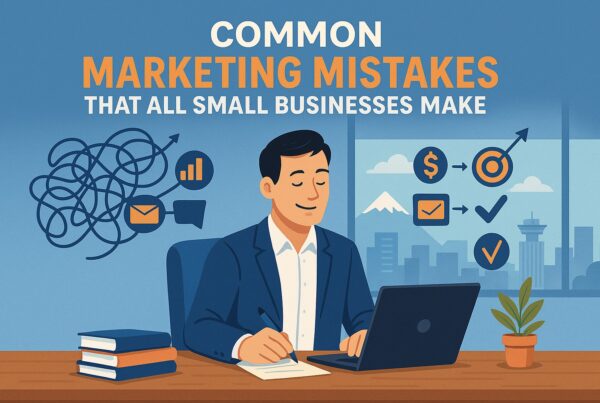The Perfect Customer Profile: The Most Profitable Marketing Move You’ll Make
Why this matters now
You don’t have a “marketing problem.” You have a mismatch problem—between what you’re offering and how your best prospects make decisions. If your ads are hit-or-miss, your social posts feel invisible, or your sales calls stall, it’s not because your product is weak or your team lacks hustle. It’s because your picture of the buyer is fuzzy.
A Perfect Customer Profile (PCP) fixes that. It’s more than a persona. It is a 360° decision map that integrates:
- Demographics (who they are)
- Psychographics (what they value and how they think)
- Jobs To Be Done (what progress they’re trying to make)
- Emotions (what motivates or blocks action)
- Buyer’s journey (how they move from unaware to loyal customer)
When you nail this, three things happen fast:
- Messaging lands—prospects feel “this is for me.”
- Channel spend shrinks—you stop paying to shout in empty rooms.
- Sales cycles shorten—you meet buyers where they are, not where you wish they were.
Ready to build a PCP that makes your marketing cheaper and more effective? Book a 15-minute call.
A clear view of your customer turns guesswork into growth.
Who you are

You’re an entrepreneur who cares about results, not vanity metrics. You’ve tested tactics—ads, SEO, events, content—and you’ve felt flashes of traction. But consistency is elusive, and the cost of “try everything” keeps rising. You want a simple, evidence-based way to direct time and budget where they’ll have the greatest impact.
If that’s you, let’s map your PCP and align it to this quarter’s revenue goal. Grab a slot here.
What a Perfect Customer Profile includes
Think of the PCP as five layers that stack to create a precise target and a practical playbook.
1) Demographics: The qualifying frame
- Company: industry, size, geography, growth stage, buying committee
- Individual: title/seniority, team size, budget authority, time in role
Purpose: Quickly filter who can buy and who cannot.
2) Psychographics: The belief engine
- Values (e.g., innovation vs. stability)
- Priorities (e.g., cash flow vs. market share)
- Risk posture (e.g., early adopter vs. conservative)
- Change triggers (e.g., leadership turnover, regulation, competitive threats)
Purpose: Shapes messages that resonate, not just inform.
3) Jobs To Be Done (JTBD): The progress they’re hiring you for
- Functional job: “Reduce acquisition cost by 20%.”
- Social job: “Look credible to my board.”
- Emotional job: “Feel safe choosing a partner who won’t embarrass me.”
Purpose: Clarifies why your solution is chosen over alternatives, including “do nothing.”
4) Emotions: The accelerators and brakes
- Gains to amplify: relief, confidence, pride, clarity
- Pains to reduce: overwhelm, risk, waste, uncertainty
- Status dynamics: esteem from peers, internal politics, reputation
Purpose: Selects hooks that move people from interest to action.
5) Buyer’s Journey: The path to purchase
- Unaware → Problem aware → Solution aware → Consideration → Decision → Onboarding → Advocacy
- Identify content, proof, and offers that match each stage.
Purpose: Ensures you say the right thing at the right time—and only then.
Want my PCP template tailored to your industry? Book a quick call and I’ll walk you through it.
Map the path. Remove the friction.
How to build your PCP in 7 practical steps
Step 1: Gather the right data (fast)
- Talk to customers: 5–10 short discovery calls > any survey. Ask about the last successful purchase, triggers, decision criteria, and internal objections.
- Mine your CRM: Look at deals won/lost, time-to-close, buying roles, channels that led to SQLs—not just MQLs.
- Interview your sales team: What questions signal real intent? Which objections kill deals?
Deliverable: A memo of qualitative themes + a spreadsheet of quantitative patterns.
Need a question script for customer interviews? Let’s set it up together.
Step 2: Define hard qualifiers (demographics)
Create a simple in/out checklist:
- In: $2–10M revenue, founder-led, 10–50 staff, Canada/US, using HubSpot, growth mandate this year.
- Out: No budget owner, procurement-only gate, no urgency driver, purely price shoppers.
Outcome: SDRs and ads stop chasing bad fits.
Step 3: Surface belief patterns (psychographics)
From interviews, tag phrases that reveal priorities or posture:
- “We move fast but hate rework.” (speed + quality)
- “We’ll invest if we see a 3-month payback.” (ROI horizon)
- “We trust peers more than ads.” (proof > promotion)
Outcome: Messaging that mirrors their worldview.
Step 4: Write the JTBD statements
Format: When [trigger], I want to [progress], so I can [outcome].
Examples:
- When new competitors undercut prices, I want to reduce dependency on paid ads to sustain margins.
- When my board asks for predictable growth, I want to build a lead pipeline we can forecast so that I can keep our expansion plan on track.
Outcome: Copy your sales team can repeat in discovery, proposals, and follow-ups.
I’ll help you turn your JTBD into landing-page copy that converts. Book a call.
Step 5: Map emotions to moments
For each journey stage, list one desired feeling and one risk feeling.
| Stage | Desired Emotion | Risk Emotion | What to Provide |
|---|---|---|---|
| Problem aware | Relief (“Finally, someone gets this”) | Overwhelm | A short diagnostic/checklist |
| Solution aware | Confidence | Skepticism | Side-by-side comparison + case study |
| Consideration | Safety | Risk of looking foolish | Cohort proof, references, pilot |
| Decision | Clarity | Confusion | Clear pricing, ROI model, implementation plan |
| Onboarding | Momentum | Buyer’s remorse | 30-day quick wins plan |
Outcome: Emotion-first enablement, not generic sales collateral.

Step 6: Align channels to behaviours (spend less, convert more)
Your PCP should name the rooms where your best buyers already hang out and why:
- LinkedIn: if buyers research peers and value thought leadership—content = briefs, voice-of-customer posts, ROI calculators.
- YouTube/Shorts: if they search “how to” and comparisons. Content = demos, teardown videos, customer clips.
- Events/Peer groups: if social proof fuels decisions. Content = roundtables, case walkthroughs, workshops.
- Email/Nurture: if multiple stakeholders must be aligned. Content = sequenced micro-briefs, objection handlers, mini-business cases.
- Search/SEO: if they’re solution-aware and time-constrained. Content = landing pages by use case, JTBD pages, pricing, implementation.
Outcome: Channel strategy that reflects how they buy, not how we hope they’ll buy.
Unsure which channels to prune or double down on? Book a 15-minute review and I’ll provide a channel map.
Step 7: Turn PCP into a one-page Operating System
One page, seven boxes:
- Segment Name & Fit Criteria
- Top Problems/Triggers
- JTBD Statements
- Emotional Drivers & Fears
- Buying Committee & Roles
- Journey Stages & Required Proof
- Channels, Offers & Metrics
Pin it in your CRM. Train the team. Review monthly.
Want my one-page PCP OS with example copy? Let’s tailor it to your business.
Alignment beats effort when it comes to growth.
What makes this approach cost-effective
- Fewer but sharper campaigns: With clear qualifiers and beliefs, you remove 30–50% of wasted impressions by not targeting poor fits.
- Message-market lock: Ads and posts built on JTBD and emotions earn higher CTR and reply rates because they mirror real buyer progress.
- Sales enablement that enables: Reps get a journey-anchored narrative and know which proof to deploy when.
- Better forecasting: A shared journey language reduces pipeline guesswork, making investment decisions smarter.
- Compounding learning: The PCP is a living asset; each quarter, you add insight and prune noise.
Common mistakes to avoid
- Equating “anyone with money” with ICP. If “everyone” is your market, no one is.
- Relying on demographics alone. Role ≠ motivation.
- Skipping customer interviews. Second-hand assumptions create first-rate waste.
- Confusing features with jobs. Buyers hire outcomes, not toolkits.
- Ignoring emotions. Logic justifies; emotion decides.
- Treating the journey as linear. Stakeholders jump stages—design content to accommodate.
Less spray-and-pray. More signal.
Example: Turning a vague persona into a profitable PCP
Before (persona)
- “Owner of a small business, 30–55, interested in growth.”
After (PCP)
- Segment: Founder-led B2B services, 10–40 staff, $2–10M revenue, in North America, growth mandate this year
- Beliefs: Value quality over cheapest, want a 90-day payback, trust peer validation.
- JTBD:
- When a new competitor undercuts rates, I want to productize services so I can stop racing to the bottom.
- When my pipeline is feast-or-famine, I want a predictable lead engine so I can hire confidently.
- Emotions: Relief from chaos, pride in a professional brand, safety in a proven plan
- Journey Highlights:
- Problem aware → diagnostic checklist
- Solution aware → “mechanics vs. magician” content (process proves expertise)
- Consideration → small paid pilot with clear win criteria
- Decision → ROI model + references + implementation plan
- Channels: LinkedIn posts and customer clips, SEO use-case pages, partner webinars, nurture emails to CFO/COO stakeholders
Result: Fewer leads, higher close rate, lower CAC, faster time-to-value.
Want me to help convert your persona into a PCP that closes? Book your 15-minute consult.
Make it visible. Keep it simple. Iterate monthly.
Implementation checklist (save this)
- 5–10 customer interviews completed
- CRM export of won/lost with source and role
- In/Out fit criteria agreed by sales + marketing
- 3–5 JTBD statements written and approved
- Journey stage map with required proof assets
- Channel plan aligned to behaviours (not habits)
- One-page PCP OS published to the team
- Monthly review cadence scheduled
Objections you might have
- “We already know our customer.” Great—prove it with interviews and win/loss data. The point isn’t to replace intuition; it’s to pressure-test it.
- “This will slow us down.” Two weeks of focused PCP work saves months of wasted spend.
- “Our market is too broad.” Segment by triggers and JTBD. Create two or three targeted PCPs, not a single, bloated PCP.
- “We can’t afford more research.” You can’t afford not to—because every vague campaign burns cash.
A short conversation can save you months of drift.
The stakes
If you skip this, You’ll keep spending to reach people who won’t buy, your team will burn out on tactics, and “maybe next quarter” will become the default plan.
If you commit to the PCP: You’ll focus on best-fit buyers, align the team, reduce CAC, increase win rates, and create marketing that consistently earns attention—because it reflects how your customer truly decides.
Next step
You don’t need another tool. You need clarity. A two-week sprint can transform your marketing from a cost line to a predictable engine.
- We’ll run customer interviews, review your CRM, craft JTBD, map emotional drivers, align channels, and publish your one-page PCP OS.
- Your team will get the scripts, assets, and a 90-day action plan.
Let’s make your marketing pay for itself.
👉 Book your 15-minute call now
P.S. Keep improving
Your Perfect Customer Profile should evolve. Markets shift, competitors change tactics, and buyer beliefs adapt. Review monthly. Celebrate what works. Prune what doesn’t. Progress beats perfection—every time.







